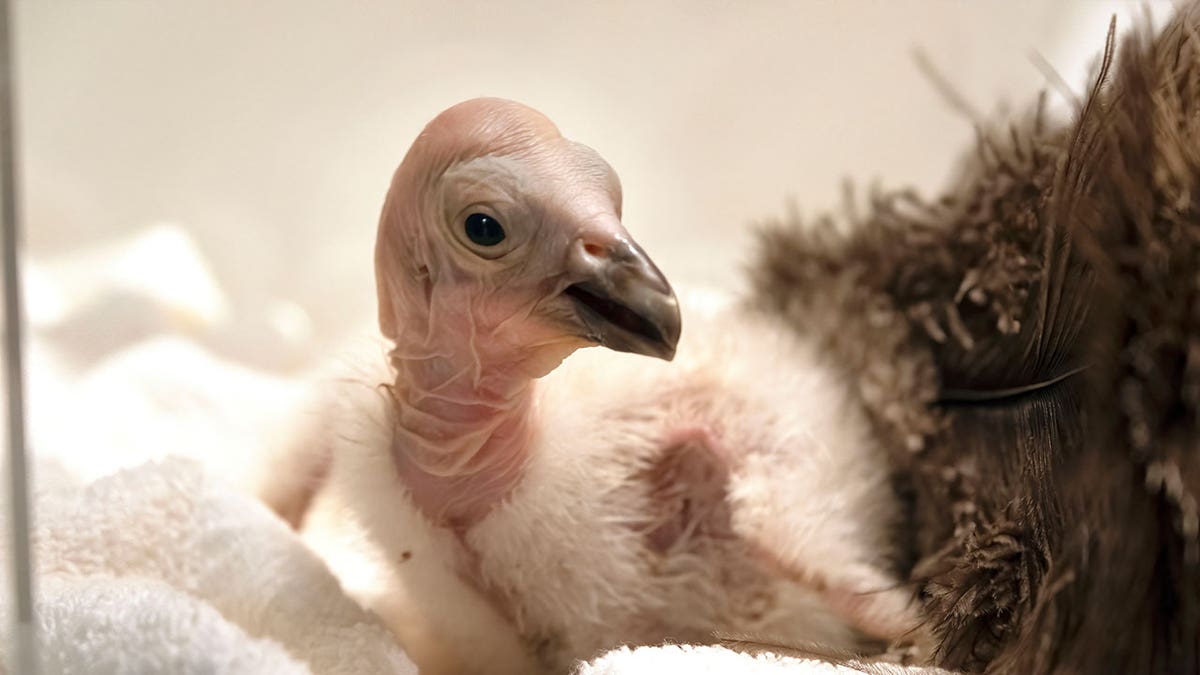Fox News Flash top headlines for May 11
Fox News Flash top headlines are here. Check out what's clicking on Foxnews.com.
The California condor is facing the deadliest strain of avian influenza in U.S. history, and the outbreak could jeopardize the iconic vulture with its 10-foot wingspan decades after conservationists saved the species from extinction.
But nine newly hatched chicks, covered in downy white feathers, give condor-keepers at the Los Angeles Zoo hope that the endangered population of North America’s largest soaring land birds will once again thrive after 40 years of aggressive efforts.
With fewer than 350 condors in the wild — in flocks that span from the Pacific Northwest to Baja California, Mexico — the historic outbreak means ongoing breeding-in-captivity and re-wilding programs like the LA Zoo's remain essential.
AVIAN FLU KILLS 20 CALIFORNIA CONDORS IN ARIZONA, UTAH
Over the past year and a half, millions of birds across the U.S. have died from avian flu, including more than 430 bald eagles and some 58 million turkeys and commercial chickens that were euthanized to prevent the spread of the disease. Bird flu is further suspected in the deaths of dozens of seals off the coast of Maine last summer.
Already, the strain is believed to have caused the deaths of at least 22 California condors in Arizona, which were part of a flock in the Southwest that typically accounts for a third of the species’ entire wild population.
Experts are now concerned the strain could further impact condors by rapidly spreading across state lines through the spring migration. More than two dozen environmental advocates this week urged the federal government to expedite approvals for a vaccine that would be given to both condors in the wild and in captivity.
The advocates, which include the Center for Biological Diversity, warned in a letter that the flu strain is "jeopardizing the existence" of the famed bird.
"The California condor is at risk of extinction once again, and once again, an emergency vaccination campaign is required to stave off a deadly infection and possible extinction," they wrote, referencing the success of the West Nile Virus vaccine for condors in the early 2000s.

Condor chick LA1123 waits for its feeding in a temperature-controlled enclosure at the Los Angeles Zoo on May 2, 2023. The chick was part of recent breeding efforts to boost the population of North America's largest land bird, an endangered species where there are only several hundred in the wild. (AP Photo/Richard Vogel)
As the 50th anniversary of the Endangered Species Act approaches, wildlife officials say the species still cannot sustain itself without human intervention — even though humans are also to blame for much of its losses outside the avian flu, including deaths from lead ammunition poisoning.
"I think it’s going to take some changes in behavior from the humans on the planet so that we can really address the threats to the species," said Ashleigh Blackford, the California condor coordinator for the U.S. Fish and Wildlife Service.
Despite a California law banning it for hunting, lead ammunition is still readily used. The condors scavenge meat from dead animals, felled by the lead ammunition, and fall ill — often fatally.
"It’s really hard to watch a bird you raised come back and die in your arms," said Los Angeles Zoo condor-keeper Chandra David, who has tended to lead-poisoned condors brought back to the zoo for treatment. "And there’s nothing we can do about it."
Still, spring is a time for hope. At breeding programs in the U.S. and Mexico, chicks are hatching and online "condor cams" provide live feeds for fans.
US SEEKS HELP TO FIND CULPRIT WHO SHOT AND KILLED 4 BALD EAGLES IN ARKANSAS
"It’s a funny species in that it really is not your typical charismatic species, right? They are a little bit on the ugly side. Most people are not endeared to vultures, but this one in particular (is different)," Blackford said.
Regardless, the condor looms large in California culture — even if it's not the official state bird (that's the California quail). The mascot for the Los Angeles Clippers is Chuck the Condor and one of the birds in flight is featured prominently on the state quarter.
The population was nearly wiped out by hunting during the California Gold Rush, as well as poisoning from toxic pesticide DDT and lead ammunition.
In the 1980s, all 22 California condors left in the wild were controversially captured and put into captive breeding programs to save the species. Zoo-bred birds were first released into the wild in 1992 and in the years since have been reintroduced into habitats they’d disappeared from — including the Yurok Tribe’s ancestral lands in Northern California. The ongoing re-wilding efforts are considered a conservation success.
"It took decades to drive species toward extinction and it’s, in many cases, going to take decades to bring them back," said Noah Greenwald, endangered species director for Center for Biological Diversity.
The condor is intrinsically tied to several Native American tribes in the West. The Havasupai people, for example, say the condor flew their ancestors from the bottom of the Grand Canyon to the top -- its wings creating the famous striations.
For the Yurok Tribe, the work to bring the condors back highlights how Native Americans are reclaiming their traditional roles as stewards of the land — "which was a role that was taken from us forcibly post-contact," said Tiana Williams-Claussen, director of the tribe's wildlife department.
Known as prey-go-neesh in Yurok, the revered condor disappeared from the region in the late 1800s. In 2021, Williams-Claussen and her team, building on a promise made by tribal leaders in 2003, watched as captive-bred condors took flight over Yurok lands for the first time in more than a century.
The tribe hopes to release four to six captive-bred birds into the wild annually over the next two decades.
"Ultimately our goal, of course, is to have birds without tags, without transmitters, that can just reintegrate into our ecosystem," Williams-Claussen said, "into our cultural lifeways again."










































